Sewing
box Index

History of sewing
boxes
Request current
list of available sewing boxes
| |
Rare first period Anglo Indian Sadeli mosaic fully fitted combined sewing and writing box Circa 1800.
Please click on images to enlarge | slide show | thumbnail index |
Reference: Sb432
Description:
SB432: Important, rare, first period sadeli mosaic fully
fitted combined sewing and writing box, retaining original turned
ivory sewing tools. The box has a retailers label:HALSTAFF AND
HANNAFORD but would have been made in Bombay India circa 1800. It is probable that the retailer/
London maker arraigned for the sewing fittings in the central tray. It was not unusual for boxes to be adjusted for the client. Circa 1800.
Origin: India Bombay
Circa: 1800
Materials: see
description.
Size: 43 cm wide by 28 cm by 13 cm: 16.9
inches wide
by 11 inches by 5.1 inches.
Condition: Very good
over all.
|
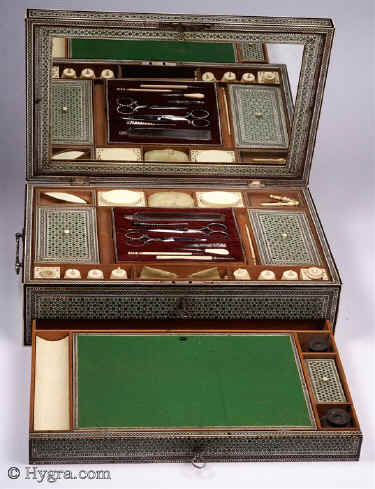
|
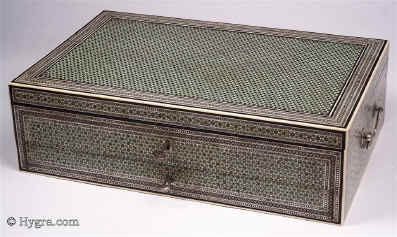
|
The box is covered in Sadeli mosiac.
The ancient art of Sadeli Mosaic is
said to have been introduced from Shiraz in Persia via Sind to Bombay, a
long time before the Anglo Indian boxes were made. It was a technique,
which required a high degree of skill and patience. It was executed very
lavishly, in that the frequent cuts wasted a great amount of the
precious materials used. The workmanship was however more than
commensurable to the value of the materials.
This type of work was highly valued in
England. Queen Charlotte (1744-1818) had three sadeli boxes in
her colection.
See: http://www.hygra.com/anglo.html#3
|
Please click on images to enlarge | slide show | thumbnail index |
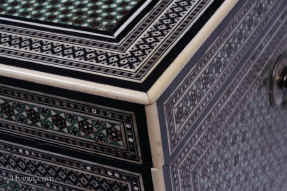
|
Detail: The mosaic work on
this box is exquisite and precise. The box is edged with solid
ivory which has been rounded. Each surface is covered with
sadeli mosaic.
|
The composition is complex. Each panel is laid out to take full
advantage of the contrasting colors and textures of the exotic and
valuable materials.
|
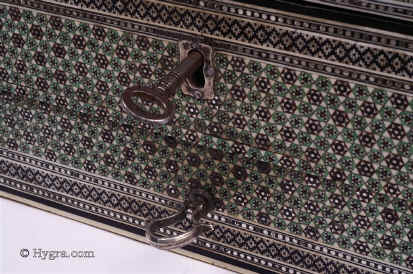
|
Please click on images to enlarge | slide show | thumbnail index |
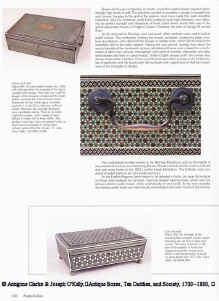
|
The box is of the same period as one illustrated in our
book.
Antique
Boxes, Tea Caddies, and Society, 1700--1880
Antigone Clarke & Joseph O'Kelly, ISBN: 0764316885
"Contemporary opinions of Bombay work, attest to the
appreciation in which it was held. A letter to Lord Clive from G.
Taswell dated 1802 exemplifies the respect shown for sadeli
work. He writes: "...Mosaic inlaid lady's workboxes... as being of
peculiar workmanship that is greatly esteemed here and to be procured
from one man, a Persee, which renders them very scarce..." It is
obvious that at least during the early stages of this work there was no
aesthetic interference. The boxes made were such as could be used by
Europeans, that is, sewing boxes, writing boxes, tea caddies, and card
boxes, but the integrity of the decoration remained intact. "
|
Please click on images to enlarge | slide show | thumbnail index |
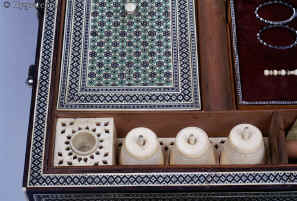
|
The inside the upper part of the box has been to accommodate
sewing tools. There are finely turned and carved thread barrels an ivory
thimble. lidded compartments.
|
The mosaic work is particularly fine and a rare
surviving masterpiece of this type of work..
The design pattern is built on a six pointed star/ hexagon. The
proportion of each element is defined by the initial central
triangle.
In the center
there is an ebony equilateral triangle with a single silver dot wrapped in contrasting silver.
If you look closely you can see the join at one of the triangle apexes.
There is added interest in that the triangles are alternately
pointing up and down. The angel is not always precise. But when the next
level, the hexagon with pewter and green colored ivory is formed the pattern
is dimensionally very accurate.
This is no mean task. The wood and ivory elements have
to be first sawed to size then scraped to be more precise. There is an extraordinary
amount of waste ending up as sawdust. A valuable fine black
pigment, ivory-black, was made with a charcoal made from the
ivory sawdust.
On each side of the triangle there is a rosewood triangle These
in turn are surrounded by triangles of alternating green-stained ivory
and pewter. This creates a hexagon. the the There are then
further triangles of rosewood.

|
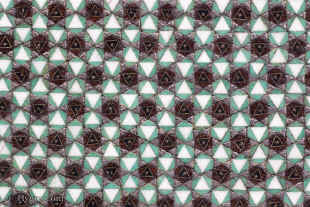
The accuracy and evenness of the layout is mind defying.
Five sizes of element in five materials are used.
|
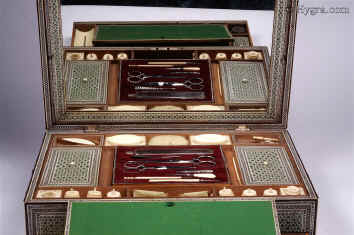
|
|
Please click on images to enlarge | slide show | thumbnail index |
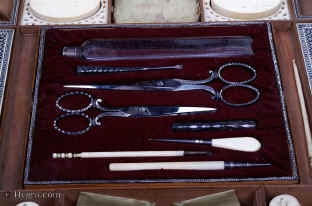
|
There is a velvet lined
liftout tray in the center.
It contains a scent bottle,
tweezers, two pairs of scissors, bodkin, needle case, and writing tools
including a pencil by Morden &Co.
It is probable that the retailer/
London maker arraigned for the sewing fittings in the central tray. It
was not unusual for boxes to be adjusted for the client.
|
| The drawer is fitted as a writing slope. The writing
tablet still retains its original green baize. The curved pen tray is
ivory. There are two contemporary inkwells. |

|
Please click on images to enlarge | slide show | thumbnail index |
Please click on images to enlarge | slide show | thumbnail index |
| Under the writing box surface there is a compartment
for paper. |
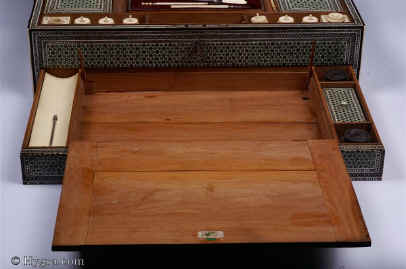
|

|
The back of the writing slope has a label:
"Halstaff, Manufacturers, 228 Regent Street.
Late of Margaret St."
HALSTAFF AND
HANNAFORD: Manufacturers 228 Regent St . Another firm straddling the
time between the Regency and the time of Victoria , making exceptional
quality glamorous boxes. Emphasis on strengthening with brass corners,
brass surrounds.
See: pages 255, 294 Antique
Boxes, Tea Caddies, and Society, 1700--1880
Antigone Clarke & Joseph O'Kelly, ISBN: 0764316885.
Another example of a later box with a Halstaff label is: http://hygra.com/dressing/index.html
|
Please click on images to enlarge | slide show | thumbnail index |

|
Detail: the box retains two
inkwells
|
Please click on images to enlarge | slide show | thumbnail index |
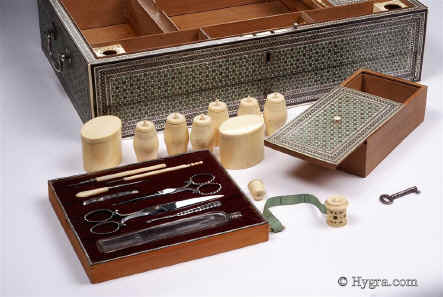
|
Detail: The box has turned ivory thread barrels, a
pair of oval ivory small boxes, an ivory thimble, and a silk tape measure.
|
Please click on images to enlarge | slide show | thumbnail index |

|
A
|
| Turning an oval on the lathe requires a complex chuck arrangement. |
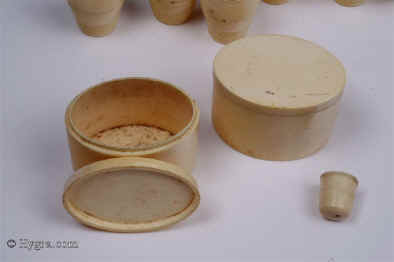
|
Please click on images to enlarge | slide show | thumbnail index |
The ivory thread barrels have a central spindle and a screw
top. The thread remains clean by being pulled from the hole in the
side.
|
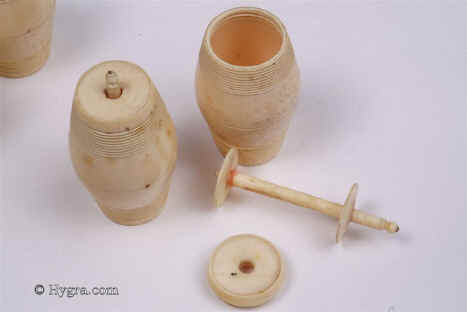
|
Please click on images to enlarge | slide show | thumbnail index |
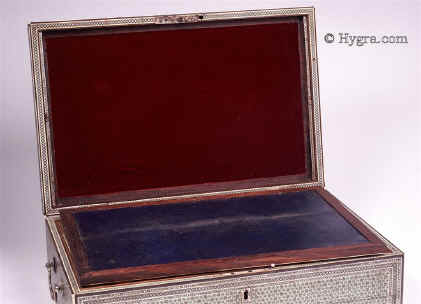
|
The mirror in the lid comes out. Behind it is lined
with red velvet |
The facings are inlaid with a fine mosaic made from ivory and
ebony.
|
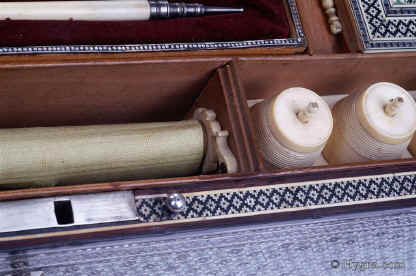
|
Please click on images to enlarge | slide show | thumbnail index |
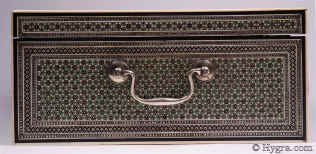
|
Silvered carrying handles to
the side
|
Please click on images to enlarge | slide show | thumbnail index |
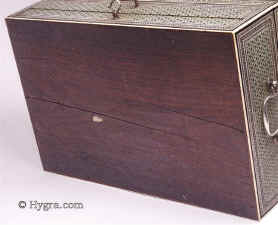
|
The bottom is made from rosewood |
Please click on images to enlarge | slide show | thumbnail index |
Please click on images to enlarge | slide show | thumbnail index |
Please click on images to enlarge | slide show | thumbnail index |
Please click on images to enlarge | slide show | thumbnail index |
Please click on images to enlarge | slide show | thumbnail index |
All text and images and linked images are ©
1999-2009 Antigone Clarke and Joseph O'Kelly. If you require any further
information on permitted use, or a licence to republish any material, email us
at copyright@hygra.com
|
